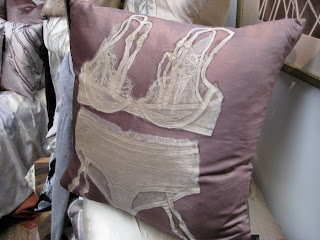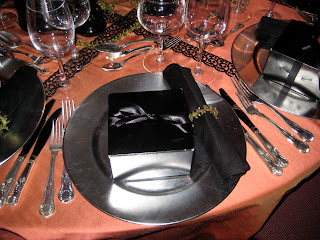Tuesday, March 29, 2011
Red, White and Great All Over
I knew what to expect this evening, sort of. My friend and fellow blogger M. told me all about it. But I still was unprepared for the spectacle of quilts on display at the Park Avenue Armory. The cavernous hall provided the perfect minimal backdrop for the 650 pieces on display, highlights from the newest collection of New York's American Folk Art Museum (thanks to a generous gift from Joanna S. Rose).
The quilts are American and mostly 19th century, and none of the makers are identified. Patterns, traditional and geometric, share space with graphics ranging from names, animals and prayers. You've got until March 30 to see these at the Armory, but keep an eye out for the grand debut of the entire collection at the American Folk Art Museum—and perhaps at a museum near you.
Friday, March 18, 2011
DIFFA Dining by Design
It's All About Design
It's the New York Design Festival!
Scratching your head? I did too when I finally got the memo. Trying to capitalize on the fact that hordes of architects, interior designers and all related and peripheral industries descend upon the town for the annual Architectural Digest Home Design Show at Pier 94, New York Mayor Michael Bloomberg declared the festival official.
This is actually a good thing. There's much going on this week into next, and it would be a shame not to catch at least some of it while there's still time.
The week got off to a good start Monday night with the pre-renovation party for this year's Kips Bay Designer Show House, scheduled to open April 28 on East 63rd Street. The house—once owned by John Hay Whitney, an ambassador to the U.K. under Dwight Eisenhower and a lifelong philanthropist—finds the benefit show back on the Upper East Side of Manhattan after an Upper West Side real estate kerfuffle last spring resulted in a much-delayed run. (I hope that won't permanently bar the folks at Kips Bay from considering a future UWS site.)
More on this year's Kips Bay show house: http://kipsbay.org/show-fundraiser.php?id=199
On Tuesday, the A&D Building hosted the second annual Educational Forum for Design Professionals, a daylong series of seminars that included breakfast, lunch and cocktails for participants. (If you attended, make sure to turn in all required paperwork—the seminars are good for up to 6 credits for AIA, IIDA and NCIDQ.) Wednesday was quiet, but engines revved up again for this month's 7 West Designer Day (when the gift/home/tabletop/textiles showrooms open their doors directly to designers in addition to the usual retailers), scheduled to coincide with the AD show; and AIPAD Photography Show New York, presented by fine art photography galleries from around the world.
7W New York: http://www.7wnewyork.com/
AIPAD: http://www.aipad.com/photoshow/new-york/
Thursday also marked the debut of the Artist Project. Unlike most shows, where the interested buyers connect with third parties such as dealers and auction houses, the Project allows collectors and the curious alike to interact directly with more than 150 independent artists. In this economic climate, any breaking down of walls, real or imagined, is welcome.
The Artist Project: http://www.theartistprojectny.com/
And so that all doubt is laid to rest about this sustainability thing, the design festival ends on Monday, March 21, with GREENleaders, a six-hour training program in green home furnishings presented by the AD show, the New York Design Center and the Sustainable Furnishings Council.
More about the Sustainable Furnishings Council: http://www.sustainablefurnishings.org/
The real draw this week, though, remains the Architectural Digest Home Design Show, which continues until Sunday, March 20. In its tenth year, the event features the latest in residential design, from furniture to kitchens, decorative accessories and technology. Lectures, seminars and cooking demonstrations round out the four days of exhibition. Participants include vendors large and small, local and international. Skram (New York), Ligne Roset (France), Sub-Zero (United States), USM-Haller (Europe) and Val Cucina (Italy) are but some of the 300 or more showing their wares.
 |
| WolfHome's beautiful silk fabrics (above & below) |
 |
| Home goods in wool felt, handmade in Kyrgyzstan |
 |
| Beautifully constructed fun, made in Brooklyn by Aviva Stanoff |
 |
| Glass by Nine Iron Studios |
The biggest trend this year? Color. Rich reds and stunning yellows found their way into the usual collection of neutrals. Natural fabrics and handmade goods are back as well.
DIFFA Dining by Design, the annual tabletop design showcase that benefits AIDS research and outreach, wasn't immune. The best tables celebrate color as well as texture.
Hurry before it all ends. Festivals like this don't grow on trees.
 |
| Winter wonderland by Scandia |
 |
| Kravet's DIFFA contribution |
 |
| Liebherr |
 |
| Even Coca-Cola got into the act. |
 |
| Table by BFA & MFA students of New York School of Interior Design |
 |
| Garden fantasy by David Beahm Design |
Saturday, March 12, 2011
Back to the Future
I got to see two sides of the design coin this week. Mario Buatta, the Prince of Chintz, was honored this week as part of a gala fund-raiser benefiting the New York School of Interior Design, my alma mater. The evening began with cocktails at the Avenue Antiques and Art Show at the Park Avenue Armory. Nearly two hours later, invited guests entered the Beaux Arts-style Metropolitan Club and found its gilded ballroom made intimate by candlelight, barely restrained floral arrangements, and a celebratory and ebullient mood. NYSID alumni and colleagues mingled, exchanged stories and met with old friends before enjoying a simple yet delicious dinner, followed by tributes in verse and song to Mr. Buatta, long celebrated for his penchant for exuberant florals and color, matched with a finely tuned eye for antiques and scale. The 75-year-old designer glowed and laughed appreciatively, praising his colleagues for the ballroom decorations and accepting the tribute with grace.
NYSID's table and place setting; color and elegance abound. |
The next night I found myself listening intently in a small auditorium at the Museum of Arts and Design as architects Michael Graves, Granger Moorhead and Gisue Hariri, as well as industrial designer Jeffrey Bernett, contemplated the state of American furniture design. The international perception is that there is no American furniture outside of office systems. To a great extent, the world is right. Much to the chagrin of the panel and those in attendance, innovation has given way to mass industrialization, where profit is king and craftsmanship holds little value. There's hope yet: Small-scale workrooms and manufacturers, working with forward-thinking designers, are poised to take furniture and product design back to the future. Technology aids the craftsman -- and woman! -- and new materials spur new approaches to old conundrums.
The Ring Cuff by Gisue Hariri for Swarovski, a tea kettle for Target by Michael Graves, contract seating for Coalesse by Jeffrey Bernett, and Moorhead & Moorhead's Felt Stool |
The lines between design disciplines have blurred as well. Hariri & Hariri's architectural/interior design commissions continue to garner praise; Gisue Hariri wore a stunningly severe crystal necklace from the new jewelry line she and her sister and design partner, Mojgan, created from Swarovski (the company has started several small, studio-like entities that work closely with designers to launch hand-creafted products, including decorative lighting and jewelry). Both Mr. Bernett (through his Studio B) and Mr. Moorhead, with his brother Robert, have new products in the pipeline. ranging from car seats to modular screens, and each has partnered with companies large and small to release their work. Mr. Graves and Target remain partners—though product releases come less frequently—and his architectural practice continues apace.
All the panelist expressed cautious optimism for the present and future of American furniture design—and American innovation in general. Watching the young, diverse audience nod in agreement and gather for impromptu discussions as the panelists adjourned, I felt the same optimism.
Heads, design wins. Tails, we all win.
Subscribe to:
Comments (Atom)











































